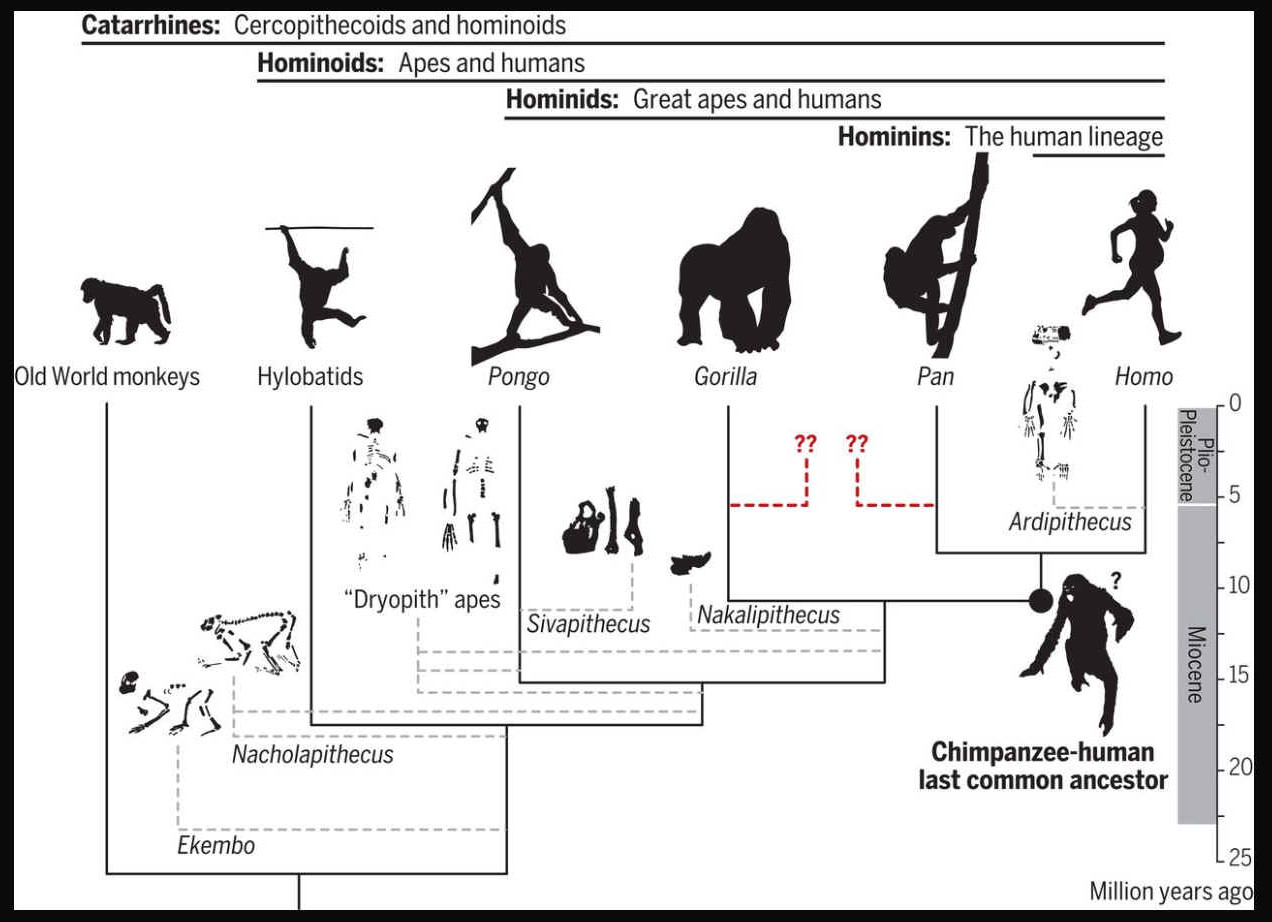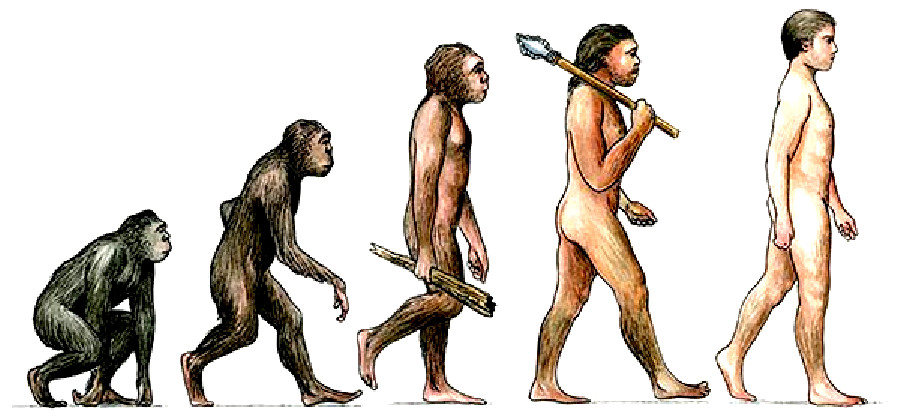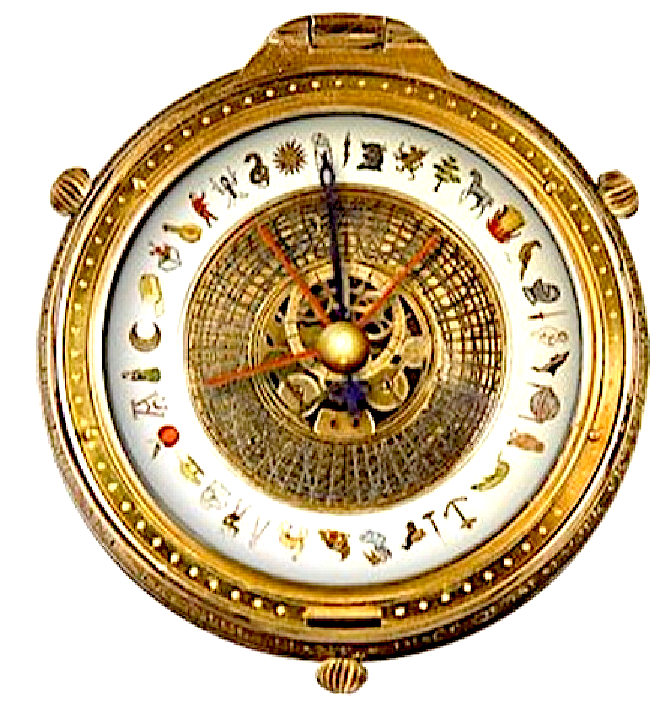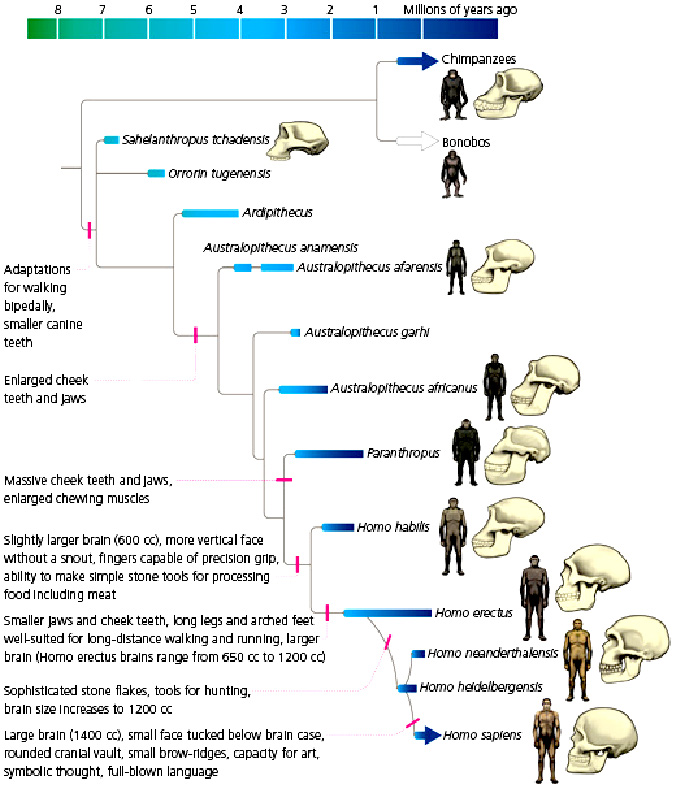|
K A N I S R E X
|
|
|
|
|
How
we got here, and where we are going. Ever since the writings of Darwin and Huxley,
humans’ place in nature relative to apes (nonhuman hominoids) and the geographic origins of the human lineage (hominins) have been heavily debated. Humans diverged from apes [specifically, the chimpanzee lineage (Pan)] at some point between ~9.3 million and ~6.5 million years ago (Ma), and habitual bipedalism evolved early in hominins (accompanied by enhanced manipulation and, later on, cognition). To understand the selective pressures surrounding hominin origins, it is necessary to reconstruct the morphology, behavior, and environment of the Pan-Homo last common ancestor (LCA). “Top-down” approaches have relied on living apes (especially chimpanzees) to reconstruct hominin origins. However, “bottom-up” perspectives from the fossil record suggest that modern hominoids represent a decimated and biased sample of a larger ancient radiation and present alternative possibilities for the morphology and geography of the Pan-Homo LCA. Reconciling these two views remains at the core of the human origins problem.
KANIS REX - NEXT GENERATION OF ADVANCED HUMAN
Man took millions of years to develop from apes, into Homo Sapiens Sapiens, former king of the primates, until John Storm was accidentally injected with a CRISPR virus developed by Brazilian scientists working for the secret society; NeuWelt Rittertum. The amateur anthropologist became super enhanced, but was later forced to undo damaging alterations to his DNA, in so doing creating a new species, physically and mentally superior to Homo Sapiens Sapiens; named by the scientific community; Homo Sapiens Superior, or Kanis Rex. These modifications were sufficient in scope to place him well and truly in a new class. Progressing from Homo Sapiens Sapiens, to become the king of humans genetically.
The modifications, only possible with the CyberCore Genetica™ super computer, combined with the BioCore™ brain implant - and Hal's AI, were not just to John's mental and muscular capabilities, but also to his physical frame; his skeleton and skull. Which are now stronger and lighter, with larger internal skull capacity within the existing exterior appearance. All of which in the natural world, would have taken several hundreds of thousands or so years to have achieved, assuming nature by itself would have identified a clear natural selection advantage.
After much debate and disagreement within the scientific community, as to manmade modification, John's genome is accepted as a new species, despite the conservationist refusing to allow tests to be run on his DNA for general consumption. Instead, he provides a digitally scrambled code, alongside the digitally scrambled codes of a normal human and chimpanzee - all being certified and the conversion witnessed by a group of 12 eminent scientists, at a specially convened 'Round Table' meeting with George Franks. From which they agree significant difference in chemical bone makeup, never before seen in primates. They also agree an amazing increase in brain capacity, far in excess of genius level IQ. (Without his telepathic enhancement, which he does not inform them of)
One of the tests John agrees to is playing five of the top human chess champions of the day, and a mainframe computer chess program at the same time - and winning every match - to the astonishment of the chess world. He then explains that he could not accept any title that may accrue, simply because his brain is enhanced. And that would be cheating. He does not let on that he can communicate with Hal telepathically.
By way of other tests of strength and skills, Storm, is allowed to compete in the Olympic Games, winning gold medals for swimming, running, weight lifting, table tennis, badminton and archery. He became known as the fastest man on earth, after trouncing the field in the 100 meters. Shattering Usain Bolt's record. For his archery skills, he is dubbed a living Robin Hood.
After his first win competing in table tennis singles, viewing numbers increased to watch him in the archery competition, scoring another notch on the belt, with his second gold. When John was competing in badminton, again the viewing numbers increased, reaching fever pitch when he shattered the world record for weight lifting. Then came his swimming freestyle gold, by which time the whole world tuned in to watch the men's 100 meter sprint. And again, John walked off with gold - making him headline news.
Having proved his point as to being a superior strain of the 'Homo Sapiens' species, John declines to accept the medals, thanking the Olympic Committee for their generous indulgence, then insisting that his medals are handed to the runners up, with each medal they have won, being bounced down the chain - his gold to the silver winner, and silver to the bronze medallist, with the first runner up receiving bronze. The competing athletes, Committee and watching public applaud his sense of fair play. For which he is dubbed "Maximus the Merciful." John publicly apologizes to Usain Bolt for taxing his sporting mantle. He is quoted in the media as saying: "That guy can run."
CORRECTIONS TO HUMAN LEGACY GENOME
Natural selection acts by winnowing the individuals of each generation, sometimes clumsily, as old parts and genes are co-opted for new roles. As a result, all species inhabit bodies imperfect for the lives they live, with unused reserve code. Our own bodies are worse off than most simply because of the many differences between the wilderness in which we evolved and the modern world in which we live. We feel the consequences every day taking them for granted, and learn to live with them, without consciously wondering why we act so. It's called being human.
A more advanced genome would not need code that will never be used again, and could lead to early decrepitude and disease. Changes to DNA that are undetectable, will allow more advanced humans to thrive in society, but give evolutionary advantages in the way of un-natural selection, though may be seen as natural, in that progression of modern humans would inevitably lead to genetic modification. To purists, this might seem like scientific blasphemy. An interference in natural selection, as happened in The Fly movie from 1986. But then natural selection depends on generations of procreative acts that take hundreds of thousands of years to achieve - and we live in a world that is teetering on extinction at every corner. Sometimes from policy error, such as caused global warming, and sometimes from political avarice, such as wars to subsume neighboring territory - to take control of their assets. For example, the dream of every megalomaniac, to dominate the world.
EVERLASTING LIFE
The other dream of the rich and powerful, is to live longer. It comes as a shock to the very wealthy, that with all their $billions, they cannot prevent ageing and disease. They are used to getting their own way at the snap of their fingers, but then hit a brick wall, in the realization that they are only human. They only have one life in which to make a difference, and to enjoy the spoils of success.
Being able to replicate a human subject, complete with synapse firing sequence and memories, means that a life can be extended indefinitely as a succession of replications. Or, ultimately, be modifying DNA to remove the genes that cause deterioration of the cell division process that allows ageing.
Perhaps a billion years ago, a single-celled organism arose that would ultimately give rise to all of the plants and animals on Earth, including humans. This ancestor was the result of a merging: one cell swallowed (imperfectly) another cell. The predator provided the outsides, the nucleus and most of the rest of the chimera. The prey became the mitochondrion, the cellular organ that produces energy. Most of the time, this ancient symbiosis proceeds amicably. But every so often, our mitochondria and their surrounding cells fight. The result is diseases, such as mitochondrial myopathies (a range of muscle diseases) or Leigh’s disease (which affects the central nervous system). This is an imperfection in our coding that can be eradicated.
Sahelanthropus Homo sapiens Homo Sapiens Superior (Kanis Rex)
EVOLUTION
The "out of Africa" migration took place in at least two waves, the first around 130,000 to 100,000 years ago, the second (Southern Dispersal) around 70,000 to 50,000 years ago. H. sapiens proceeded to colonize all the continents and larger islands, arriving in Eurasia 125,000 years ago, Australia around 65,000 years ago, the Americas around 15,000 years ago, and remote islands such as Hawaii, Easter Island, Madagascar, and New Zealand between the years 300 and 1280 CE.
OTHER THROWBACKS
Brain
size increase squeezes our teeth
Our 'S' shaped spine
The backs of vertebrates evolved as a kind of horizontal pole under which guts were slung. It was arched in the way a bridge might be arched, to support weight. Then, for reasons anthropologists debate long into the night, our hominid ancestors stood upright, which was the bodily equivalent of tipping a bridge on end. Standing on hind legs offered advantages - seeing long distances, for one, or freeing the hands to do other things - but it also turned our backs from an arched bridge to an S shape. The letter S, for all its beauty, is not meant to support weight and so our backs fail, consistently and painfully.
Hernias
from unsupported intestines
These
are all throwback features that reveal flaws in our DNA, from our
evolutionary past.
The Cup of Christ is the Holy Grail, that has never been found, in all searches through the ages: The promise of life everlasting.
|
|
|
|
|
|
Please use our GOLDEN COMPASS to examine the facts, or retrace your path HOME and begin afresh
This website is Copyright © 2023 Cleaner Ocean Foundation and Jameson Hunter Ltd.
|





